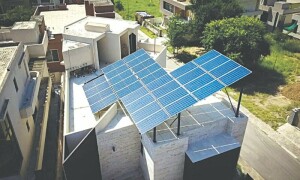On a year-on-year basis, food prices rose 16.6 per cent in urban centres and 19.3pc in rural areas, with headline inflation at 12.28pc in November. But growers complain that low produce rates at farm gates continue to be outpaced by high farm input prices. The federal government has announced a subsidy of Rs100 billion for agriculture, but details are awaited.
Concerned about the hike in fertiliser rates, the cabinet has set up a committee to look into the prices of both urea and diammonium phosphate (DAP). The National Assembly’s Special Committee on Agriculture Production has decided to ask the Competition Commission of Pakistan (CCP) to present its findings on the profit margins of various fertiliser products.
According to a recent media report, Pakistan Kissan Ittehad President Khalid Mehmud Khokhar said the cost of farm production had increased by 70-80pc. Over time, he elaborated that the per-bag price of urea had surged from Rs1,300 to Rs2,040 and that of DAP rose from Rs2,300 to Rs3,700.
The electricity rate for agriculture has tripled from Rs5.35 per unit to Rs15 or more. The production of crops is falling owing to the high cost of farm inputs. Poor growers cannot afford the fertiliser cost. Based on his own estimate of the current cotton crop, he said, “Poor women who pick cotton will get Rs40bn less. Small farmers have been crushed.” One can also assess the state of the farm economy from the drastic fall in demand for tractors.
High input costs and low output prices result in a huge transfer of resources from rural to urban centres every year
Based on the daily Central Cotton Committee reports, analysts estimate the season’s cotton production to be 10.8 million bales, roughly one-third short of the targeted 15m bales. This slump is attributed to the fact that many farmers shifted from cotton to sugar cane for better returns notwithstanding the continuing tussle between growers and sugar mills over pricing and the delayed payments. Unlike cotton, the cane plantation lasts for one year and provides growers with some financial space.
High input costs and low output prices result in a huge transfer of resources from rural to urban centres. This leaves a vast majority of growers with limited savings so they can’t invest in farm modernisation (that is moving at a snail’s space) and maximising production. This results in a low yield per acre.
The more frequently used inefficient mode of production based on share-cropping contracts, coupled with the tenant’s insecurity, that is governed by tradition rather than law and controlled by rent-seeking landlords deprives the tenants of fair compensation and incentives to improve productivity.
Usually, big landlords give small units of cultivation to each tenant where modern implements of agriculture cannot be used. In case of large landholdings, crop-sharing enriches absentee landlords who still stay in place despite land reforms of Ayub Khan and Zulfikar Ali Bhutto. Even the decision by the Bhutto government taken as far back as January 1977 to replace land revenue by agriculture income tax has yet to be effectively implemented by provincial governments.
No doubt some corrective measures are being taken. Sindh has launched a project funded by the European Union with a contribution of 400 euros and supported by the Food and Agriculture Organisation (FAO) under which about 4,800 informal contracts will be improved and formalised through voluntary guidance.
The FAO representative in Pakistan, Mina Dowlatchahi, said: “This land tenure governance strategy for Sindh contains practical recommendations to help the government to promote secure tenure rights and equitable access to land and water as a means of eradicating hunger and poverty, supporting sustainable development and protecting natural resources.” The project is targeted to benefit 12,800 households in eight districts.
Corporate crop farming that could enhance the per-acre yield has made virtually no headway. An effort to attract Arab investment in this area failed owing to strong domestic resistance. Most local corporate entities are operating in the field of seed, poultry and food processing, including dairy farming. A couple of family-owned and -run corporate entities engaged in crop production can be counted on fingertips.
Asian Development Bank’s (ADB) support has also been sought. ADB chief for rural development and food security Akmal Siddiq says the bank’s assistance programme includes the introduction of corporate agriculture on a wider scale in Balochistan, especially the Kachhi canal area.
Land reforms are a common feature in all countries that have made rapid socioeconomic progress. Incidentally, Bangladesh’s economic performance, which is better than Pakistan’s, can be traced back to the upper limit of 33 acres on self-cultivated land imposed in 1950. India is another example.
With the stated aim to stimulate investment in agriculture, President Ayub Khan launched his government’s land reforms in 1959. Apart from the distribution of land, Mr Bhutto’s first phase of land reforms announced in 1972 was aimed at doing away with absentee landlordism and introducing tenancy reforms and adopting latest technologies. If the three phases of reforms (including that of January 1977) were effectively implemented, land holdings would have been reduced to 100 acres of irrigated land and 200 acres of non-irrigated land.
Under the 1972 reforms, land resumed by the state without paying any compensation to landowners was distributed free among landless tenants and peasants with individual holdings not exceeding subsistence holding. Many landless tenants did not have the resources to bring their allotted land under cultivation. In most cases, it went back to the landlords.
So we have 45pc of the country’s population engaged in agricultural production contributing mere 21.5pc of GDP. The United States is producing a huge farm surplus for worldwide consumption with just 2pc of its population engaged in agriculture.
The low farm yield per acre in Pakistan has made agricultural produce globally uncompetitive, accentuated conflicts of interest among stakeholders and induced successive cash-strapped governments to provide all kinds of subsidies that it can ill-afford.
Published in Dawn, The Business and Finance Weekly, December 23rd, 2019















































